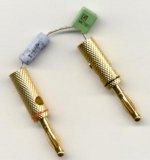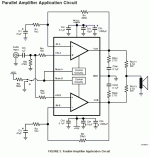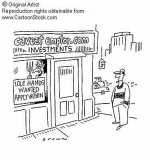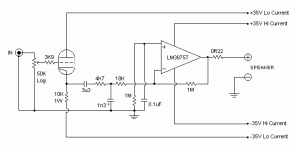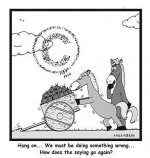I really like the idea of a switch. Easy to A/B. Not counting the effect of the switch itself. Also, it was nice to reread the philosophy behind the gaincard again. Learn from masters. I'll paraphrase to save you a click:
[
Extreme simplicity ----- minimum circuitry
The heart of sound lives in the point of contact where musician and instrument meet. To trace this point-of-contact sound wave, Model 4706 utilizes a filter/condenser with the smallest possible capacity and a minimum number of parts, and the shortest signal pass length ever. All the parts (except attenuators) are mounted on a circuit board measuring 45 x 30 m/m per channel.
Powerful voltage regulation
If energy supply depends on the capacity of filter/condensers, you can easily lose the freshness of sound. The high capacity transformer of Model 4700 (170 VA) regulates enough energy to support the extremely small filter/condenser (1000 F) of Model 4706, enabling it to trace avalanches of fff.
True values of NFB
Today's amplifier design trend tends to eliminate the use of NFB in circuitry. However, for those speakers with long strokes, NFB is still an effective device. But the length of NFB loop creates a time delay between the original and the return signals and allows noises to enter. To take full advantage of NFB, we shortened the length of the feedback loop on Model 4706 to 9m/m, which includes the length of the resistor. We achieved this breakthrough by utilizing power IC and intricate point-to-point hand wiring.
Rigid and compact chassis structure
The Model 4706 chassis is constructed from two tubular aluminum frames (40 x 80 m/m section) and front and rear panels of 10m/m thick machined aluminum plate. Each left and right channel circuit is encased in a separate chassis to eliminate interference between them and to achieve dual mono structure. Model 4700's chassis is also made out of 130 m/m aluminum tube and has 10 m/m thick front and rear machined aluminum panels. Both models contain no damping materials at all.
]
[
Extreme simplicity ----- minimum circuitry
The heart of sound lives in the point of contact where musician and instrument meet. To trace this point-of-contact sound wave, Model 4706 utilizes a filter/condenser with the smallest possible capacity and a minimum number of parts, and the shortest signal pass length ever. All the parts (except attenuators) are mounted on a circuit board measuring 45 x 30 m/m per channel.
Powerful voltage regulation
If energy supply depends on the capacity of filter/condensers, you can easily lose the freshness of sound. The high capacity transformer of Model 4700 (170 VA) regulates enough energy to support the extremely small filter/condenser (1000 F) of Model 4706, enabling it to trace avalanches of fff.
True values of NFB
Today's amplifier design trend tends to eliminate the use of NFB in circuitry. However, for those speakers with long strokes, NFB is still an effective device. But the length of NFB loop creates a time delay between the original and the return signals and allows noises to enter. To take full advantage of NFB, we shortened the length of the feedback loop on Model 4706 to 9m/m, which includes the length of the resistor. We achieved this breakthrough by utilizing power IC and intricate point-to-point hand wiring.
Rigid and compact chassis structure
The Model 4706 chassis is constructed from two tubular aluminum frames (40 x 80 m/m section) and front and rear panels of 10m/m thick machined aluminum plate. Each left and right channel circuit is encased in a separate chassis to eliminate interference between them and to achieve dual mono structure. Model 4700's chassis is also made out of 130 m/m aluminum tube and has 10 m/m thick front and rear machined aluminum panels. Both models contain no damping materials at all.
]
The switch is not just for comparison. I've already done that and found Zobel to affect adversely the sound. You'd provide it for situations where you might need it.
Jamh said:I really like the idea of a switch. Easy to A/B. Not counting the effect of the switch itself. Also, it was nice to reread the philosophy behind the gaincard again. Learn from masters. I'll paraphrase to save you a click:
[.....
The heart of sound lives in the point of contact where musician and instrument meet. To trace this point-of-contact sound wave, Model 4706 utilizes a filter/condenser with the smallest possible capacity and a minimum number of parts, and the shortest signal pass length ever. ]
Obviously the gaincard was a major contribution and that many people like the sound. It is certainly a good implementation and has a minimal number of parts. So it is certainly worth emulating.
But we should not fool ourselves that we are particularly close to the "point-of-contact soundwave" were the musician and instrument meet.
There are preamps and amplifiers on instruments and mics, there are mixers, there is filtering, there is mastering etc. Considering the huge amount of wire, the very large number of opamps, the vast amount of supporting analog circuitry, and the additional digital massaging that music goes through before it hits the CD the marketing statement about the gaincard putting you close to where the the musician meets the instrument is well, marketing.
This does not detract from the gaincard being a good amp. Nor does it add or detract from discussions about adding or eliminating components. But in the end it is on the tail end of a long chain of electronics.
I know you can do better than that
"You don't really need a switch to compare effect of Zobel. Here's what I'm using." -PD

From the data sheet:
"LAYOUT, GROUND LOOPS AND STABILITY
The LM4780 is designed to be stable when operated at a
closed-loop gain of 10 or greater, but as with any other
high-current amplifier, the LM4780 can be made to oscillate
under certain conditions. These oscillations usually involve
printed circuit board layout or output/input coupling issues.
When designing a layout, it is important to return the load
ground, the output compensation ground, and the low level
(feedback and input) grounds to the circuit board common
ground point through separate paths. Otherwise, large currents
flowing along a ground conductor will generate voltages
on the conductor which can effectively act as signals at
the input, resulting in high frequency oscillation or excessive
distortion. It is advisable to keep the output compensation
components and the 0.1µF supply decoupling capacitors as
close as possible to the LM4780 to reduce the effects of PCB
trace resistance and inductance. For the same reason, the
ground return paths should be as short as possible.
In general, with fast, high-current circuitry, all sorts of problems."
*Parallell amps call for a zobel for each amp
I can't understand how someone so particular about component quality and lead length could completely throw all that out the window and call this a legitimate attempt at implementing zobel networks. We have all seen your meticulous work and hold you to the high standards that you have set for your self and which others aspire to. I am not surprised at bad results with such a half hearted attempt with incredibly inductive long leads and very poor component choice. I know 1% metal film resistors below 10 ohms are hard to find. Strap three or four 10 1/4 watt resistors in parallel in series with a decent cap 100 V polypropylene cap with short leads installed as described in the data sheet. I would put the footprint a 1206 SMT resistor and stack 3 or 4 of the 10 ohms on top of each other . Also you could use a XICON 2.7 ohm 5% 1206 SMT (Mouser 263-2.7) or Yageo 2.7 ohm 5% 1206 SMT(DigiKey 311-2.7ECT-ND). There are also some 1% Panasonic 1206 SMT in the Digikey catalog. I was feeling a little guilty about all this until I saw the picture of the "network". Know what a self fulfilling prophecy is?
We know you can and almost always do better than this and we have come expect the highest quality layout and parts quality from you and this isn't even close. I really urge you to give it a shot at your usual standards and report back..... positive or negative results as you honestly see them. Don't forget break-in and letting the amp warm up for the optmum time required.
"You don't really need a switch to compare effect of Zobel. Here's what I'm using." -PD

From the data sheet:
"LAYOUT, GROUND LOOPS AND STABILITY
The LM4780 is designed to be stable when operated at a
closed-loop gain of 10 or greater, but as with any other
high-current amplifier, the LM4780 can be made to oscillate
under certain conditions. These oscillations usually involve
printed circuit board layout or output/input coupling issues.
When designing a layout, it is important to return the load
ground, the output compensation ground, and the low level
(feedback and input) grounds to the circuit board common
ground point through separate paths. Otherwise, large currents
flowing along a ground conductor will generate voltages
on the conductor which can effectively act as signals at
the input, resulting in high frequency oscillation or excessive
distortion. It is advisable to keep the output compensation
components and the 0.1µF supply decoupling capacitors as
close as possible to the LM4780 to reduce the effects of PCB
trace resistance and inductance. For the same reason, the
ground return paths should be as short as possible.
In general, with fast, high-current circuitry, all sorts of problems."
*Parallell amps call for a zobel for each amp
I can't understand how someone so particular about component quality and lead length could completely throw all that out the window and call this a legitimate attempt at implementing zobel networks. We have all seen your meticulous work and hold you to the high standards that you have set for your self and which others aspire to. I am not surprised at bad results with such a half hearted attempt with incredibly inductive long leads and very poor component choice. I know 1% metal film resistors below 10 ohms are hard to find. Strap three or four 10 1/4 watt resistors in parallel in series with a decent cap 100 V polypropylene cap with short leads installed as described in the data sheet. I would put the footprint a 1206 SMT resistor and stack 3 or 4 of the 10 ohms on top of each other . Also you could use a XICON 2.7 ohm 5% 1206 SMT (Mouser 263-2.7) or Yageo 2.7 ohm 5% 1206 SMT(DigiKey 311-2.7ECT-ND). There are also some 1% Panasonic 1206 SMT in the Digikey catalog. I was feeling a little guilty about all this until I saw the picture of the "network". Know what a self fulfilling prophecy is?
We know you can and almost always do better than this and we have come expect the highest quality layout and parts quality from you and this isn't even close. I really urge you to give it a shot at your usual standards and report back..... positive or negative results as you honestly see them. Don't forget break-in and letting the amp warm up for the optmum time required.
Attachments
Well, as I said earlier:
I was already discussing it with Brian, and I don't see a problem with implementing those addirtional parts on the current board, for everybodys peace of mind ( and successfull sales). I would hate to lose some customers because Zobel was missing😉
I never tried Zobel with parallel LM4780 chips, and quite honestly, I can't say how it would work in that circuit. Based on my experience with LM3875, I didn't expect it would be needed here (and in some cases it probably won't be needed). I built one prototype without Zobel and after trying it in 3 different systems I didn't experience any oscillations.
The jumper I showed previously, works fine with my LM3875 based amps, as the circuit actually hangs around binding posts, so all traces and ground returned paths are extremally short.
I didn't use the best components here, but the average ones, something that most people would have probably used anyway. I don't know what's wrong with those Panasonic resistor is, according to Fred. Those are the choice of Nelson Pass and he uses them extensively in Alephs. Also ROE is not bad capacitor, and it's the same quality as Wima used by Kimura in a GainCard. So parts quality shouldn't be affecting the influence of Zobel network. The leads might be on a long side, but nithing to worry about, really.
That guy here http://www.bla.de/images/rig/gainclone_new_zobel.jpg uses the Zobel much further away from the amp's circuit and he still likes it.
Peter Daniel said:I don't have problems with installing Zobel, as long as it won't affect current layout. One reason for that is that I also want to use those boards in some of my commercial offerings, and I will not be using Zobel (probably).
But also this amp seems like a perfect candidate to drive subwoofers, and in that case Zobel shouldn't affect sonics, so why not to use it, right?
I was already discussing it with Brian, and I don't see a problem with implementing those addirtional parts on the current board, for everybodys peace of mind ( and successfull sales). I would hate to lose some customers because Zobel was missing😉
I never tried Zobel with parallel LM4780 chips, and quite honestly, I can't say how it would work in that circuit. Based on my experience with LM3875, I didn't expect it would be needed here (and in some cases it probably won't be needed). I built one prototype without Zobel and after trying it in 3 different systems I didn't experience any oscillations.
The jumper I showed previously, works fine with my LM3875 based amps, as the circuit actually hangs around binding posts, so all traces and ground returned paths are extremally short.
I didn't use the best components here, but the average ones, something that most people would have probably used anyway. I don't know what's wrong with those Panasonic resistor is, according to Fred. Those are the choice of Nelson Pass and he uses them extensively in Alephs. Also ROE is not bad capacitor, and it's the same quality as Wima used by Kimura in a GainCard. So parts quality shouldn't be affecting the influence of Zobel network. The leads might be on a long side, but nithing to worry about, really.
That guy here http://www.bla.de/images/rig/gainclone_new_zobel.jpg uses the Zobel much further away from the amp's circuit and he still likes it.
Unfortunately Fred is right. Most of you miss what he is trying to say. The option for a Zobel network should have been in the original design.
What about the oscillation a different settings on the volume control of the inverting circuit……….what a farce.
What I see here for the most part is a bunch of “parts swappers” who have forgotten or wont listen to basic design practices and scratch their heads when it doesn’t work or blows up.
I can agree with Jamh that a Zobel can hurt the sound but if the amplifier oscillates what is worse………I would look to see if the design works for it’s intended application before I started wondering if brand X resistors are better.
Regards,
Jam
P.S. Hint. if you have an amplifier with global feedback leave the option for a Zobel network in.
What about the oscillation a different settings on the volume control of the inverting circuit……….what a farce.
What I see here for the most part is a bunch of “parts swappers” who have forgotten or wont listen to basic design practices and scratch their heads when it doesn’t work or blows up.
I can agree with Jamh that a Zobel can hurt the sound but if the amplifier oscillates what is worse………I would look to see if the design works for it’s intended application before I started wondering if brand X resistors are better.
Regards,
Jam
P.S. Hint. if you have an amplifier with global feedback leave the option for a Zobel network in.
Neither Joe Rasmussen's JLTi , no Thorsten's original schematic carries a Zobel network http://jwg.student.utwente.nl/fedde/audio/images/invertedLM3875.gif
There were countles amps built around those schematics, and rarely oscillations occured. Even in case of oscillations, it was not presence of Zobel that eliminated them. It was usually improper wiring. I know about it, as I was closely following all those posts.
I also had an amp in one system, that was badly distorting. Adding Zobel didn't fix the problem. Changing for different speaker cables did.
There were countles amps built around those schematics, and rarely oscillations occured. Even in case of oscillations, it was not presence of Zobel that eliminated them. It was usually improper wiring. I know about it, as I was closely following all those posts.
I also had an amp in one system, that was badly distorting. Adding Zobel didn't fix the problem. Changing for different speaker cables did.
Attachments
Mass produced commerically sold amps definitely need zobel networks. Its the issue of designing to the lowest common denominator, making an amp stable for all possible conditions. The National semiconductor data sheet is aimed at the amp designer for these large markets. They don't make any money from us, well maybe a couple of hundred bucks a year.
The Audiophile and DIY communities are a different matter all together. We can easly add a zobel, filter, and extra bypass cap IF NECESSARY.
FROM THE DATA SHEET
"These oscillations usually involve
printed circuit board layout or output/input coupling issues."
This where we should attack the oscillations problem. Brian looks after the PCB layout and the DIYer the output/input issues. If a problem still occurs then we add a zobel or whatever.
BTW: What are the obvious signs of oscillation, I thought it was distortion and heat?
The Audiophile and DIY communities are a different matter all together. We can easly add a zobel, filter, and extra bypass cap IF NECESSARY.
FROM THE DATA SHEET
"These oscillations usually involve
printed circuit board layout or output/input coupling issues."
This where we should attack the oscillations problem. Brian looks after the PCB layout and the DIYer the output/input issues. If a problem still occurs then we add a zobel or whatever.
BTW: What are the obvious signs of oscillation, I thought it was distortion and heat?
grege said:BTW: What are the obvious signs of oscillation, I thought it was distortion and heat?
Best case - annoying distortion. Usual case - annoying distortion plus alot of heat. Worst case - NO distortion (or apparent output) but plenty of SMOKE and attendant foul smell (and possibly fried speakers)...
🙂 🙂
Best to put a 'scope on it and see what's going on...
Cheers,
Bill
thanks netgeek,
Looks like I was on the right track. My GCs don't seem to distort and run only warm. I must buy a scope (or a CRO 😉 ) to see whats really going on.
Looks like I was on the right track. My GCs don't seem to distort and run only warm. I must buy a scope (or a CRO 😉 ) to see whats really going on.
Peter,
In your example, a Zobel was also needed at the other end of the cable(not the cables's fault, remember we are dealing with a feedback amplifier)..................and how many DIYer's have access to a scope let alone an idea what to look for if they had one. Just because several people got away with it does not make it right, you might be putting the cart before the horse in this case. If you are selling such a product you must look at the worst case senerio.
The best is to build a stable design.............and offer modifications (or options) to diyer's that had the tools to anylyze any problems should they occur, not hand a racing car to someone that did not know how to handle it......which might tread over the line of being irresponsible?
Regards,
Jam
In your example, a Zobel was also needed at the other end of the cable(not the cables's fault, remember we are dealing with a feedback amplifier)..................and how many DIYer's have access to a scope let alone an idea what to look for if they had one. Just because several people got away with it does not make it right, you might be putting the cart before the horse in this case. If you are selling such a product you must look at the worst case senerio.
The best is to build a stable design.............and offer modifications (or options) to diyer's that had the tools to anylyze any problems should they occur, not hand a racing car to someone that did not know how to handle it......which might tread over the line of being irresponsible?
Regards,
Jam
Attachments
Greg,
Unless you're doing alot of building/designing - paying the big bucks for a 'scope is probably not worth your while. If it were me - I'd squander the extra bucks buying VB's down at The Rocks...🙂
Regards,
Bill
Unless you're doing alot of building/designing - paying the big bucks for a 'scope is probably not worth your while. If it were me - I'd squander the extra bucks buying VB's down at The Rocks...🙂
Regards,
Bill
Somewhat off topic...but...
You know - these two recent posts have given me an idea. Alot of DIY folks don't have (or need usually) the type of test equipment that might be useful to them in their projects. And in many cases, even if they did have them, there's a learning curve involved so that they could properly capture and interpret the results.
I have piles of (relatively) expensive test equipment laying around - alot of it infrequently used - but I need the stuff for my work. I wonder about the DIY guys that don't have access to this stuff but could certainly make good use of it - even if only for a few minutes that might be required to solve a particular problem or question.
What if there were a separate section of this forum that listed under "resources" people who were willing to share their equipment and/or expertise with others? For example - I'm currently living in the Washington DC area. If some DIYer needed to use some equipment to solve a problem or answer a question I certainly wouldn't mind letting them use this stuff (or running it for them - since it may be rather overwhelming) for a short period of time. They could bring their project over and we could hook it up and see what needs to be seen, and they would then have the information they need without spending big bucks on stuff they don't need otherwise.
Would it be worthwhile to set up such a section on this forum which provided contact info in various geographic areas - a "yellow pages" of volunteers?
Maybe this should be moved to a separate thread if there are any opinions - but since the posts above are what got me started on this I'll post it here for now...
Regards,
Bill
grege said:I must buy a scope (or a CRO 😉 ) to see whats really going on.
jam said:..................and how many DIYer's have access to a scope let alone an idea what to look for if they had one.
You know - these two recent posts have given me an idea. Alot of DIY folks don't have (or need usually) the type of test equipment that might be useful to them in their projects. And in many cases, even if they did have them, there's a learning curve involved so that they could properly capture and interpret the results.
I have piles of (relatively) expensive test equipment laying around - alot of it infrequently used - but I need the stuff for my work. I wonder about the DIY guys that don't have access to this stuff but could certainly make good use of it - even if only for a few minutes that might be required to solve a particular problem or question.
What if there were a separate section of this forum that listed under "resources" people who were willing to share their equipment and/or expertise with others? For example - I'm currently living in the Washington DC area. If some DIYer needed to use some equipment to solve a problem or answer a question I certainly wouldn't mind letting them use this stuff (or running it for them - since it may be rather overwhelming) for a short period of time. They could bring their project over and we could hook it up and see what needs to be seen, and they would then have the information they need without spending big bucks on stuff they don't need otherwise.
Would it be worthwhile to set up such a section on this forum which provided contact info in various geographic areas - a "yellow pages" of volunteers?
Maybe this should be moved to a separate thread if there are any opinions - but since the posts above are what got me started on this I'll post it here for now...
Regards,
Bill
jam said:Peter,
In your example, a Zobel was also needed at the other end of the cable(not the cables's fault, remember we are dealing with a feedback amplifier)..................and how many DIYer's have access to a scope let alone an idea what to look for if they had one. Just because several people got away with it does not make it right, you might be putting the cart before the horse in this case. If you are selling such a product you must look at the worst case senerio.
The best is to build a stable design.............and offer modifications (or options) to diyer's that had the tools to anylyze any problems should they occur, not hand a racing car to someone that did not know how to handle it......which might tread over the line of being irresponsible?
Regards,
Jam
I don't think I was clear. This is a stable design. As long as I won't encounter a single case where oscillations occur, I will not install Zobel in my commercial amps.
This is not severall people, this is almost all people (that built GC). I don't know if you follow GC cult, but this means at least 1000 amps.
If in my example with a cables, Zobel was needed at the other end of cable as well, what good does it make installing it in an amp anyway?
I believe selling the amp without coupling caps is a much bigger risk than without Zobel. Can we start talking about caps now?
hey netgeek
I'm building enough of these things (not just GCs) to probably make it worthwhile. I've had a busy two years in the garage.
Mate, you're about twenty years too late for that advise. I work close to The Rocks and can't wait to get on the train to go home. My idea of a good time now is a quite listen to my latest creation or a couple of bottles of wine with a few friends, food optional.
I like the idea of helping out with test equipment, when I get mine I'll have to let others know.
"Unless you're doing alot of building/designing - paying the big bucks for a 'scope is probably not worth your while.
I'm building enough of these things (not just GCs) to probably make it worthwhile. I've had a busy two years in the garage.
If it were me - I'd squander the extra bucks buying VB's down at The Rocks..."
Mate, you're about twenty years too late for that advise. I work close to The Rocks and can't wait to get on the train to go home. My idea of a good time now is a quite listen to my latest creation or a couple of bottles of wine with a few friends, food optional.
I like the idea of helping out with test equipment, when I get mine I'll have to let others know.
Quote from Brian GT @ 2nd Page: "The difference between the premium and basic kits is the choice of components. The premium kit will use Caddock MK132 resistors ..."
What about the basic version? what resistors does it have?
What about the basic version? what resistors does it have?
Originally posted by Peter
This is not severall people, this is almost all people (that built GC). I don't know if you follow GC cult, but this means at least 1000 amps.
Hey Peter lets get some statistics. 😀
I've built 6 Gainclones, 1 with zobel, 5 without. No obvious signs of oscillation.
- Status
- Not open for further replies.
- Home
- Amplifiers
- Chip Amps
- Do we need Zobel with chip amps?
